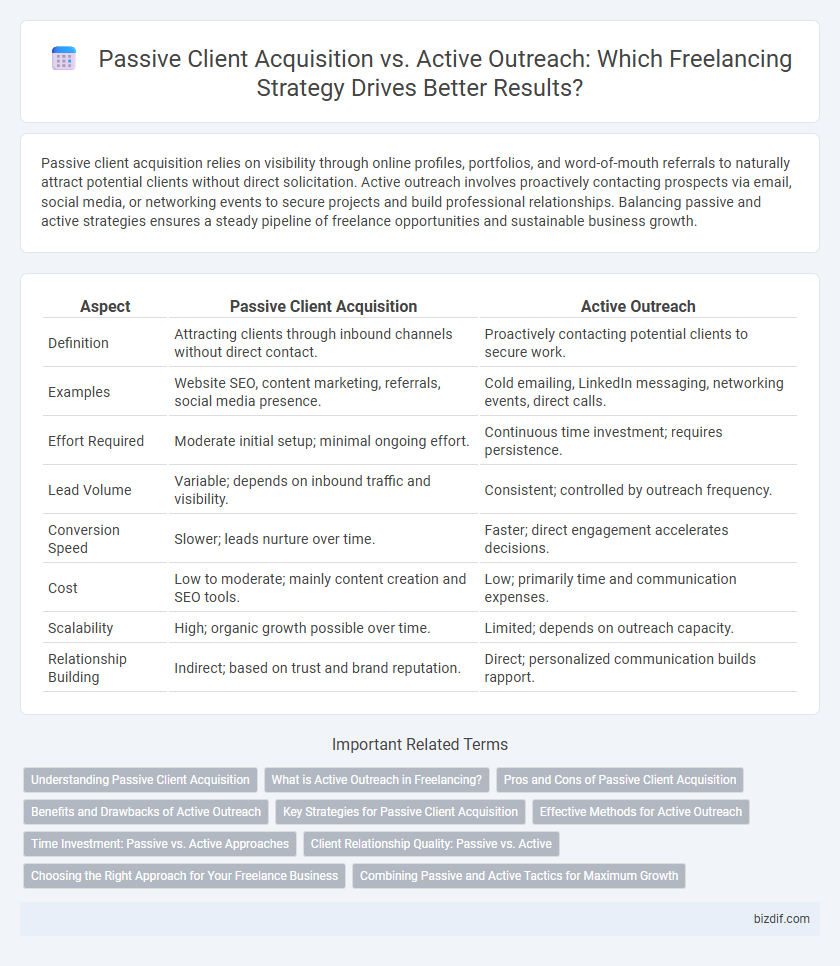Passive client acquisition relies on visibility through online profiles, portfolios, and word-of-mouth referrals to naturally attract potential clients without direct solicitation. Active outreach involves proactively contacting prospects via email, social media, or networking events to secure projects and build professional relationships. Balancing passive and active strategies ensures a steady pipeline of freelance opportunities and sustainable business growth.
Table of Comparison
| Aspect | Passive Client Acquisition | Active Outreach |
|---|---|---|
| Definition | Attracting clients through inbound channels without direct contact. | Proactively contacting potential clients to secure work. |
| Examples | Website SEO, content marketing, referrals, social media presence. | Cold emailing, LinkedIn messaging, networking events, direct calls. |
| Effort Required | Moderate initial setup; minimal ongoing effort. | Continuous time investment; requires persistence. |
| Lead Volume | Variable; depends on inbound traffic and visibility. | Consistent; controlled by outreach frequency. |
| Conversion Speed | Slower; leads nurture over time. | Faster; direct engagement accelerates decisions. |
| Cost | Low to moderate; mainly content creation and SEO tools. | Low; primarily time and communication expenses. |
| Scalability | High; organic growth possible over time. | Limited; depends on outreach capacity. |
| Relationship Building | Indirect; based on trust and brand reputation. | Direct; personalized communication builds rapport. |
Understanding Passive Client Acquisition
Passive client acquisition relies on creating a strong online presence through high-quality portfolios, SEO-optimized websites, and targeted content marketing to attract clients organically. Leveraging social proof such as testimonials, case studies, and industry certifications enhances credibility and encourages inbound inquiries without direct solicitation. This strategy reduces time spent on cold outreach and builds long-term client relationships based on trust and demonstrated expertise.
What is Active Outreach in Freelancing?
Active outreach in freelancing involves proactively contacting potential clients through personalized emails, social media messages, or networking events to secure projects. This approach requires freelancers to research target clients, tailor their pitches, and consistently follow up to build relationships and demonstrate expertise. Unlike passive client acquisition, active outreach accelerates project opportunities by directly engaging with decision-makers and addressing their specific needs.
Pros and Cons of Passive Client Acquisition
Passive client acquisition in freelancing allows professionals to attract clients organically through portfolios, social media, and content marketing, often leading to higher-quality, motivated clients. However, this approach can result in unpredictable lead flow, slower client growth, and a longer sales cycle compared to active outreach strategies. Freelancers relying solely on passive methods may face challenges maintaining consistent project pipelines and scaling their business efficiently.
Benefits and Drawbacks of Active Outreach
Active outreach in freelancing allows direct engagement with potential clients, increasing the likelihood of immediate project opportunities and faster revenue generation. This proactive approach requires consistent time investment and may result in rejection or low response rates, demanding resilience and persistence. While it accelerates client acquisition, active outreach can divert focus from skill development and project delivery if not balanced properly.
Key Strategies for Passive Client Acquisition
Utilizing a professional website optimized for SEO, maintaining an active presence on social media, and consistently publishing valuable content such as blogs or case studies form the core of passive client acquisition strategies in freelancing. Leveraging online portfolios and client testimonials enhances credibility, attracting potential clients through organic search and referrals. Investing in personal branding and network engagement creates a steady inbound flow of inquiries without direct outreach efforts.
Effective Methods for Active Outreach
Active outreach in freelancing thrives through personalized email campaigns targeting niche markets and leveraging social media platforms like LinkedIn to connect with key decision-makers. Consistently following up with tailored messages and sharing valuable content establishes credibility and nurtures potential clients. Utilizing CRM tools to track interactions and schedule communications ensures organized, efficient outreach that maximizes response rates.
Time Investment: Passive vs. Active Approaches
Passive client acquisition in freelancing relies on building an online presence, portfolios, and content marketing, requiring consistent but lower daily time investment. Active outreach demands a higher immediate time commitment through personalized emails, calls, and networking to secure clients quickly. Balancing these approaches optimizes long-term growth while managing day-to-day workload efficiently.
Client Relationship Quality: Passive vs. Active
Passive client acquisition fosters high-quality relationships by attracting clients genuinely interested in services, leading to stronger trust and long-term collaboration. Active outreach requires personalized communication tailored to client needs, which enhances engagement and demonstrates commitment but may risk seeming intrusive. Balancing both approaches maximizes relationship depth and client satisfaction in freelancing.
Choosing the Right Approach for Your Freelance Business
Passive client acquisition relies on creating a strong online presence and attracting clients through portfolios, content marketing, and referrals, which builds long-term trust and credibility. Active outreach involves proactively contacting potential clients via cold emails, social media messages, and networking events to generate immediate leads and faster project acquisition. Freelancers should evaluate their industry, time availability, and communication skills to determine whether a passive or active approach aligns best with their business growth goals.
Combining Passive and Active Tactics for Maximum Growth
Combining passive client acquisition methods such as maintaining a strong portfolio and leveraging SEO with active outreach strategies like personalized emailing and networking events maximizes freelance growth potential. Passive tactics build credibility and attract inbound inquiries over time, while active outreach accelerates relationship-building and project opportunities. This dual approach ensures a steady influx of clients, balancing long-term brand visibility with immediate business development.
Passive Client Acquisition vs Active Outreach Infographic

 bizdif.com
bizdif.com